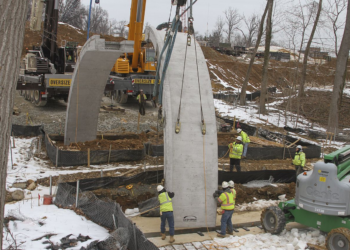After nine gruelling months in space, NASA‘s stranded astronauts have finally returned to Earth.
However, experts warn that Butch Wilmore and Suni Williams’ unplanned stay on the International Space Station (ISS) could have serious health impacts.
Shocking before-and-after images show the terrifying damage that months spent in the harsh conditions in space will do to you.
From ‘chicken legs’ and ‘baby feet’ to an increased risk of deadly cancer, experts warn that the stranded astronauts could face years of health complications.
As Williams and Wilmore emerged from their SpaceX Crew Dragon capsule yesterday, medical teams rushed to help them onto stretchers.
The astronauts will now undergo several days of intensive medical checks at NASA’s Johnson Space Center in Houston.
However, health experts have already noticed signs of physical decline in the stranded astronauts.
And even while they were on the ISS, experts expressed concern over the pair’s gaunt appearance and apparent weight loss.
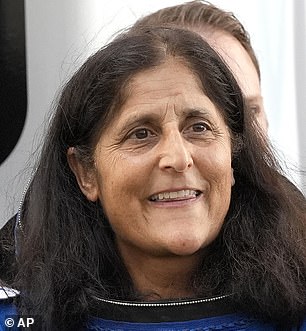
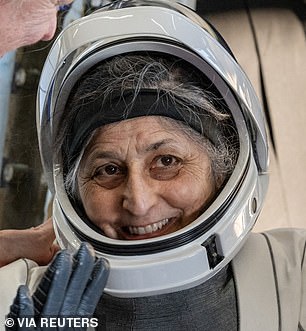
After nine gruelling months in space, Suni Williams (pictured) and Butch Willmore have finally returned to Earth. But shocking before-and-after images show the damage that their unintended stay in space has caused

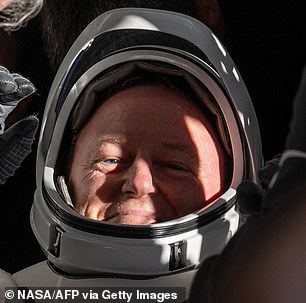
Even during their time in space, health experts raised concerns that Butch Wilmore (pictured) and Suni Williams were suffering from severe weight loss and muscle atrophe
Muscle and bone loss
The biggest risks associated with an extended time in space come from the exposure to microgravity.
Away from the pull of Earth’s gravity, astronauts muscles begin to weaken through lack of work.
Over time this leads to muscle atrophe which leaves astronauts frail upon their return to Earth.
As seen during their dramatic landing yesterday evening, astronauts are typically unable to walk in the crushing weight of Earth’s gravity.
Despite following NASA’s rigorous exercise routine aboard the ISS, both Williams and Willmore had to be helped out of the capsule and onto stretchers.
Research has shown that the changes to bone denisity can be sever and long lasting, leading to greater risk of bone fractures or skeletal issues.
Dr Vinay Gupta, a pulmonologist and Air Force veteran said the astronauts could need up to six weeks of rehabilitation to regain their strength, which will include guided exercise and a nutritional plan.
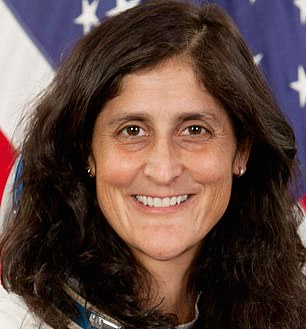
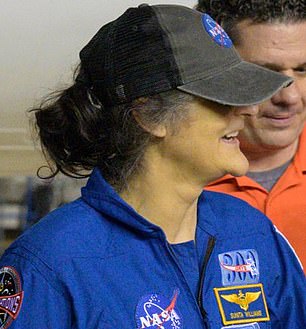
The biggest impacts of time in space are caused by exposure to microgravity and intense radiation. Being away from Earth’s pull causes astronauts muscles to weaken, leaving them with walking issues upon return
Fluid shift
Additionally, since the body is 70 per cent water, this fluid tends to shift dramatically when in low gravity.
Just as if you were hanging upside down, NASA says that over 5.6 litres of liquid can migrate upwards through the body.
In some cases this leads to an issue whch NASA calls ‘puffy face syndrome’, which causes severe swelling of the tissues in the head.
At the same time, fluid leaving the lower part of the body leads to what NASA calls ‘chicken legs’ and ‘baby feet’.
This is a condition in which the legs appear unusually small and weakened.
While these cosmetic complications will likely clear up within about three days back in regular gravity, fluid shifting can also lead to serious health issues.
Beyond looking unusual, this buildup of fluids in the head can also lead to serious medical complications.
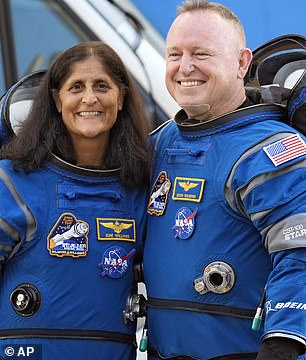
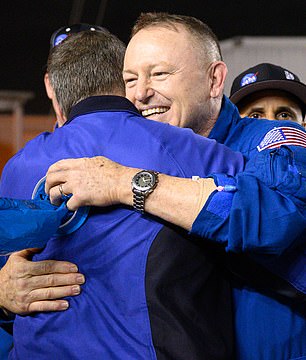
Months spent in low gravity cause fluid shifts in the body which can cause health problems ranging from ‘chicken legs’ to vision loss
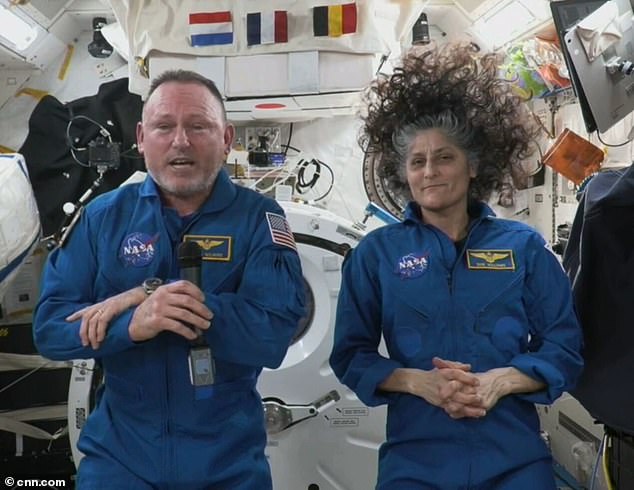
While in microgravity, shifting fluids cause increased pressure in the head which leads to ‘puffy face syndrome’
As pressure builds up in the head it presses on the eyes and on the optical nerves causing something called Spaceflight Associated Neuro-Ocular Syndrome (SANS).
SANS causes blurry or fuzzy vision, growing blind spots, and even changes to the shape of the eye.
Likewise, changing pressures in the brain has also been associated with cognitive decline in some astronauts.
The impacts of microgravity are worsened by the fact that astronauts often struggle to maintain their weight in space.
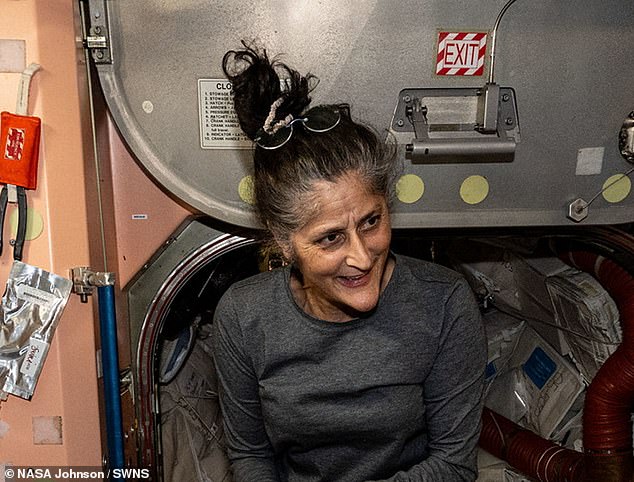
Suni Williams shocked the world when pictures of her gaunt face were released by NASA
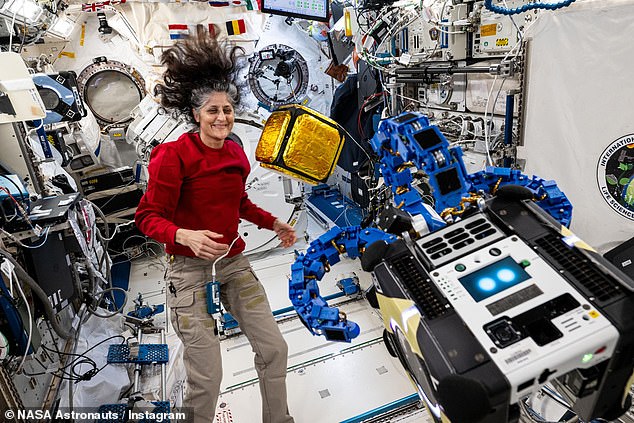
Fluid leaving the lower part of the body leads to what NASA calls ‘chicken legs’ and ‘baby feet’. Pictured: Suni Williams in space
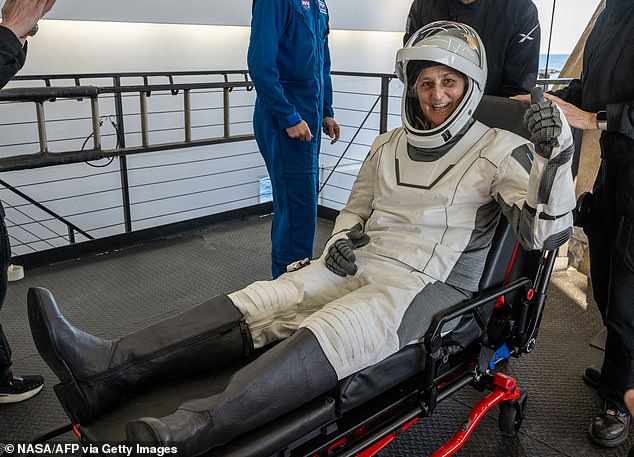
Frequent nausea and a loss of smell and taste due to pressure in the sinuses means that astronauts lose their appetites
Frequent nausea and a loss of smell and taste due to pressure in the sinuses means that astronauts lose their appetites.
In November, doctors told DailyMail.com that Williams appeared ‘gaunt’ in a photo that was taken in September and said that she looked like she had lost weight.
Later that month, an unnamed NASA source told the New York Post that the agency was scrambling to ‘stabilize the weight loss and hopefully reverse it.’
The unnamed employee who is ‘directly involved with the mission’ said that Williams has been ‘unable to keep up with the high-caloric diets that astronauts must consume’ while on the ISS.
‘The pounds have melted off her and she’s now skin and bones. So it’s a priority to help her stabilize the weight loss and hopefully reverse it,’ the NASA source said.
Later that month, Williams hit back at the weight loss ‘rumours’ in a live video published by NASA, claiming that she had actually put on muscle.
NASA astronauts who return from long ISS missions complete a 45 day rehabilitation program that requires them to exercise for two hours per day, seven days per week.
The program is tailored to the specific needs of each astronaut, according to NASA.
Phase one
Phase one of a NASA astronaut’s post-mission rehabilitation plan focuses on regaining strength, flexibility and the ability to walk.
This may include gait training exercises, range of motion exercises and obstacle training.
Gait training exercises are movements designed to improve strength, balance and coordination during walking. Examples include squats, straight leg raises, standing on one leg and seated marching.
To improve their range of motion, the astronauts may perform ankle pumps, which involve sitting or lying down while flexing the feet. They may also do stretches to loosen the calves, quadriceps and hamstrings.
Astronauts may have to navigate an obstacle course or step over and around objects to improve their coordination.
Phase two
After making some improvement during phase one the astronauts move on to phase two, which adds proprioceptive exercises and cardio reconditioning.
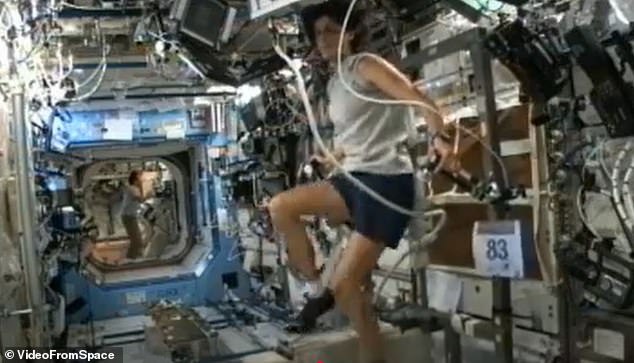
To maintain some of their strength, astronauts exercise for at least two hours per day on the ISS. Pictured: Sunita Williams uses the space station’s stationary bike during her 2012 mission
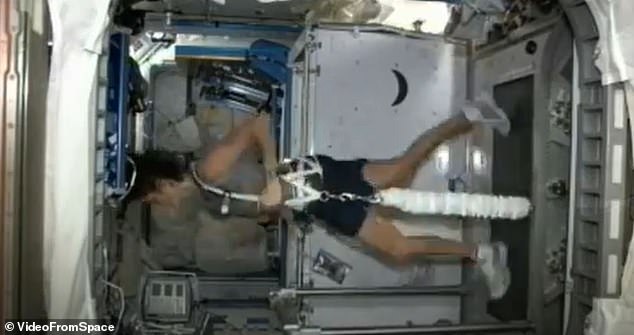
Sunita Williams runs on the ISS treadmill during her 2012 mission
Proprioceptive exercises strengthen the body and improve the mind’s perception of its movement and position.
Examples include reverse lunges, banded toe taps and sumo squats with leg raises.
Some of these exercises are more complex. Astronauts may be asked to pick an object up off the floor while standing on one leg, which requires them to hinge at the waist and maintain their balance as they bend down.
As for cardio training, the astronauts may use a treadmill, elliptical or stationary bike to get their endurance back to pre-flight status.
Phase three
Phase three, the longest phase, focuses on returning the astronaut to their optimal level of physical performance through functional development training.
This training helps astronauts regain the skills and abilities they need in order to do their jobs and fully participate in their daily lives with ease and efficiency.
It may include more high-intensity exercises, such as jump squats and jump lunges, mountain climbers, planks and dead lifts.
Most astronauts return to their re-mission fitness level after the 45 days, according to NASA.
But it can take months or even years for some to recover, and research has shown that many astronauts never fully restore their bone density.
Dr John Jaquish, a biomedical engineer, told the Daily Mail they could still recover their pre-flight bone density if they use osteogenic loading, but it won’t be easy.
This involves exercises that strengthen bones by putting stress on them, such as squats, lunges or jumping.
But in order to stimulate bone growth, the astronauts’ bones will have to bear a load 4.2 times their body weight, Dr Jaquish said.
For reference, ‘the world record squat is only four times body weight, so the minimum [weight] you need is more load than the world record holders,’ he said.
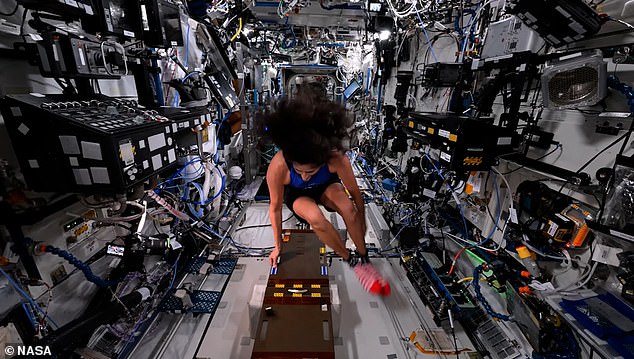
Sunita Williams and the rest of the ISS crew performed Olympic events on the space station last summer
Wasted muscles
To combat the effects of living in low gravity, astronauts exercise for at least two hours per day on the ISS.
But this still isn’t enough to stop muscle and bone loss, doctors told the Daily Mail.
Astronauts who spend long periods of time in low gravity ‘lose musculature, they lose bone density,’ Dr Jaquish said.
‘The human body needs the Earth’s gravitational pull, and in an absence of that, a lot of things are not functioning correctly.’
Research has shown that a 30 to 50-year-old astronaut who spends six months in space loses about half their strength.
This not only leaves them physically debilitated when they return to Earth, but puts them at greater risk of bone fracture and premature osteoporosis, a disease that weakens bones as people age.
To reduce these impacts, astronauts work to make sure they are in peak physical condition before they embark on an ISS mission and continue to workout on the space station to maintain their fitness.
But ‘the reality is, they’re effectively getting a fraction of the sort of exercise that we all take for granted just by walking in [Earth’s] gravity,’ Dr Gupta said.
‘Invariably, despite them doing all the right things (which I know they are) you’re going to see a decrease in muscle mass and strength — no question.’
Heart health
It’s not just their muscles and bones taking a hit. Low gravity impacts their cardiovascular health too.
This is because blood and other bodily fluids shift upwards towards the head, which means the cardiovascular system doesn’t have to work as hard to maintain blood flow to the brain.
This can result in reduced blood volume and reduced function of the heart and blood vessels, according to NASA.
Extreme radiation
Williams and Wilmore will also have been exposed to extreme levels of space radiation during their extended ISS mission.
In just one week on the ISS, astronauts are exposed to the equivalent of one year’s exposure on Earth. This may increase their risk of developing cancer, central nervous system damage, bone loss and some cardiovascular diseases, according to NASA.
‘If I was their physician, I would think about a more proactive strategy for cancer screening,’ Dr Gupta said.
‘We want to take a different approach here, given that they had such a unique exposure history,’ he said.
In addition to bone and muscle loss and cancer risk, Williams and Wilmore could be facing other debilitating health issues too.
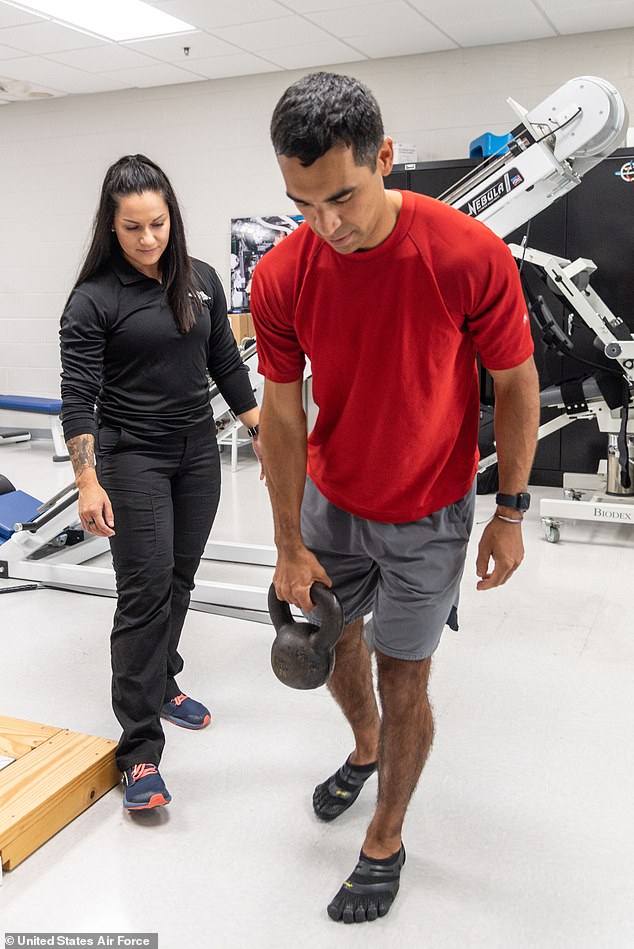
NASA astronaut Raja Chari performs strengthening exercises after returning from a 177-day-long ISS mission
‘We’re still finding out about the long-term effects of spaceflight,’ European Space Agency astronaut Tim Peake previously told LadBible. ‘But we also know that our skin ages, our eyesight changes and [that] we’re more prone to blood clots.’
‘These are relatively new things that we’ve found out. I guess the longest effect is the radiation dose, as that’s hard to quantify what the effects will be,’ he said.
In December 2015, Peake became the first British astronaut to visit the ISS. He completed his six-month mission aboard the floating laboratory in June 2016.
Skin problems
Studies have shown that spending six months on the ISS wreaks havoc on the skin.
One team of researchers found that astronauts’ epidermis gets thinner by nearly 20 percent in space, perhaps due to low gravity, which may dysregulate the skin’s ability to grow and repair itself.
Another study found that skin rashes are the most frequently reported clinical symptom during six-month ISS missions, occurring 25 percent more frequently than they do for the general US population on Earth.
These rashes may result from irritants or allergens found inside the space station, and the weakening effect that low gravity has on the immune system. Skin lesions also take longer to heal in space, according to NASA.
Fears over eyesight
Low gravity also damages astronauts’ eyesight during long-term ISS missions, sometimes leading to Space-Associated Neuro-Ocular Syndrome (SANS).
According to NASA, SANS results from bodily fluids shifting toward the head due the lack of gravity, and symptoms include swelling in the optic disc (where the optic nerve enters the retina) and flattening of the eye shape.
Astronauts’ eyes typically return to normal once they return to Earth, studies have shown.
The upward fluid shift their bodies experience on the ISS also increases astronauts’ risk of blood clots, specifically through the development of a condition known as Spaceflight Venous Thrombosis (SVT).
Some astronauts who develop SVT completely recovered after returning to Earth, but others need additional treatment, according to NASA.
Williams and Wilmore spent more than nine months on the ISS, much longer than a typical long-term mission.
This could mean that the health impacts they have experienced, and now must recover from, will be more severe than the average astronaut’s.
At this time, there is no evidence to suggest the Starliner crew is suffering from vision loss, skin lesions or SVT. But this is not out of the question.


